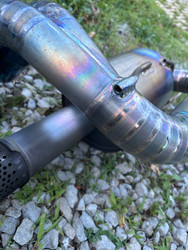Cracks, Heat, and Hangers: Real Talk on Titanium Exhaust Failures from the Track
Posted by Top Speed Pro1 on 25th Jul 2025
At Top Speed Pro-1, we’re proud to offer high-performance titanium exhaust systems that deliver both stunning aesthetics and serious weight savings. But before you choose titanium over other materials, it’s important to understand how it performs in different driving conditions — and why improper installation can lead to costly failures.
What Makes Titanium So Special?
Titanium is a top-tier material for performance exhausts for a reason:
- Ultra-Lightweight: Significantly lighter than stainless steel, helping reduce overall vehicle weight
- Corrosion Resistant: Naturally resistant to rust and oxidation
- Signature Look: Beautiful blue-purple heat discoloration over time adds to its race-inspired style
Titanium exhausts are perfect for street cars and show builds where weight, appearance, and tone are key.
⚠️ The Trade-Off: Rigidity, Heat, and Installation Stress
Titanium is incredibly strong, but it's also more rigid and brittle than stainless steel. Instead of flexing under stress, it can crack when exposed to:
- Excessive vibration from hard launches or chassis flex
- Repeated thermal cycling from rapid heating and cooling
- Misaligned mounting points or improper installation, which can put undue stress on hanger welds and connection points
Cracks commonly appear around high-stress areas such as the muffler inlets/outlets and hanger welds, not necessarily at the main piping welds. These stress points are especially vulnerable during track use.
Additionally, titanium’s low thermal conductivity means heat can concentrate in localized areas. On track cars, especially when driving in lower gears for extended periods, this can lead to discoloration and structural fatigue around support areas if not properly installed.
Track Cars: Titanium or Stainless?
While titanium exhausts are ideal for street use, we do not recommend them for regular track use or motorsport applications. For racing or aggressive driving, stainless steel systems are the better choice:
- Heavier, but much more ductile and forgiving
- Better able to handle high vibration and sustained heat
- Less likely to crack under pressure or from installation issues
If you’re planning to hit the track, stainless steel will give you peace of mind and long-term durability.
✅ Our Recommendation:
- Choose Titanium if you want the lightest setup, beautiful color finish, and are focused on aesthetics or mild performance
- Choose Stainless Steel for daily driving, track use, or if your car sees harsh conditions
At Top Speed, we’re here to help you find the right system for your needs. Reach out to our team anytime if you need help selecting the best material for your build.
Have Questions?
We’re happy to help. Visit https://topspeedauto.com or contact us for personalized recommendations.
Stay fast, stay safe.
Top Speed Pro-1 Team
Tags: Titanium Exhaust, Titanium Exhaust Cracks, Exhaust System Guide, Stainless Steel vs Titanium, Track Car Exhaust, Performance Exhaust Systems, Top Speed Pro-1, Lotus Exige Exhaust, Exhaust System Failures, Motorsport Exhaust Tips, Exhaust Installation Tips, Aftermarket Exhaust Systems, Titanium Exhaust Maintenance, Lightweight Exhaust, Cracked Exhaust Repair



